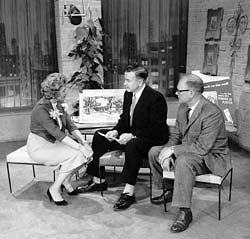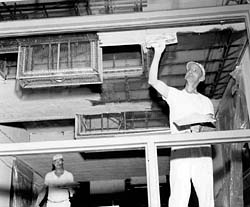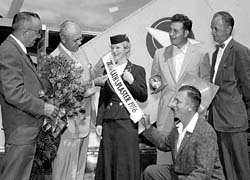

"We're funded by a collective bargaining agreement," explains Executive Director Steve Pedracine. "Benefits for membership include technical help, promotion of the industry and even helping contractors find work by maintaining good relationships with architects."

Eisenhower era
An urgent need for public relations spurred the founders of the bureau back in 1953, when Dwight Eisenhower was sworn in as president (on live TV!), the average cost of a new home was $16,000, the Yankees beat the Brooklyn Dodgers in the World Series and a gallon of gas was $0.21.Dave Roe and Lloyd Peterson were two of the Bureau's founders.
"Peterson was a very aggressive plastering contractor," recalls Roe, now retired. "He held a meeting and we talked about promoting our industry. Keep in mind that at that time, 95 percent of the homes built were lath and plaster. We wanted to make sure we kept that moving."
A national bureau had been established in Washington that same year and the founders of the Minnesota Bureau felt it would be in their interest to establish a local bureau. The group consensus was that the industry needed promotion.
"We wanted to join the National Bureau of Lathing and Plastering," continues Roe. "When we established ours, we were one of the first to establish a bureau and one of the first to send a check to the national bureau to sustain that effort. The check was returned years later and hangs in the office today."
A three-cents-per-hour contribution to the Minnesota Bureau was established that first year. The founding members sold the idea to their unions, who resisted at first but eventually agreed.

Surrounded by drywall
It was 11 years earlier, in 1942 that Roe recalls drywall creeping into the industry."That year, the lathers in Minneapolis were awarded by national jurisdiction, first dibs on drywall," Roe adds. "Lathers did not take to it because in one sense, they felt they were aiding and abetting the demise of their craft by helping drywall. Reluctant to use it, the carpenters came in and moved in that direction. Had the lathers maintained the jurisdiction of drywall, all drywall work would have been done by lathers and not carpenters, which would have made us the biggest local in Minnesota."
Roe explains that lathers believed they could hold their own against drywall, that they did not count on the fact that one could hang wallboard, tape it and be done, rather than having to lath, scratch, brown and finish.
"Our work was quality work but more time consuming," Roe says. "And builders thought drywall was more convenient."
The accomplishments made by that initial team included inroads with architects and selling them on lath and plaster. The bureau also advertised for builders who specified plaster, free of charge. The bureau focused mostly on the commercial market with the slogan, "Knock on the wall tells all."
"I think we made the industry here work more closely," Roe says. "We all found ourselves in the same boat and this was reflected in the attitude employers had toward us as representatives of the lathing and plastering industry. Today, the director of the Bureau must look at the industry as a whole-there are more aspects, with plaster, EIFS, drywall, stucco in the mix-and go to the architects and continue to promote it."
Another of the old timers is Clint Fladland, a salesman who joined the bureau in 1957.
"Because I was a salesman with experience working with architects and builders, they felt plaster as a commodity was losing ground and needed some selling," Fladland recalls. "We had a PR firm working with us, advertised on TV, radio and newspapers. I made hundreds of personal calls and we even did presentations on the values of plaster over drywall."
Fladland also recalls that drywall was not met with the greatest of respect from lathers.
"Lathers came from proud old families who have been involved in the craft for generations," he adds.
Fladland also agrees that in hindsight, losing drywall jurisdiction to carpenters was a mistake that contributed to the demise of many plasterers. However, there was a second component to lathers' turning away from drywall besides pride: profit.
"At that time, people in drywall were not making the same wages or profits as the plasterers," Fladland explains. "Plasterers therefore thought that they could not make money installing a cheap product. Plaster had a good price with a good profit and good wages, so we went full steam ahead. We felt because much of the market was going non-union that we could successfully capture the institutional market, schools, government buildings and hospitals. Eventually, many customers could no longer afford not to go drywall."
Fladland worked in the industry for 35 years.

The 21st century
Today, the Minnesota Lath & Plaster Bureau continues to promote its industry. Unfortunately, in addition to promoting the industry, Pedracine also laments that there must be effort made in defending the industry."I worked for Parex in the 1990s, and in 1996, we had the Carolinas moisture intrusion situation go down," Pedracine says. "I was down there investigating and remediating in those years. In 1999, I thought it would be a refreshing change to join the Bureau here but lo and behold, there were stucco water-intrusion issues to address."
Pedracine explains his role as executive director will continue to include the development of technical materials, and a Web site to stand alone for architects so that they can receive information to do their job, which is vital to the continuing success of bureau.
"I think perhaps what distinguishes me from my predecessors is technical acumen," he adds. "Nancy Strohmayer, our office manager, has been here through each of our tenures and has told me on a number of occasions that each of us has operated differently. As a former schoolteacher and technical representative for an EIFS manufacturer, I perhaps put more emphasis on effective communication, education and the technical nature of the lath and plaster disciplines."
Pedracine reminds that the bureau operates differently than in the past.
"We are not putting placards on buses or hosting local television shows," he says. "As strange as it may seem, we are looking at 30-second TV spots that tie to the local union message. However, those types of endeavors, unlike the past, can become costly. What we do now, is spend a lot of time on the lecture circuit, giving box lunch presentations to architectural firms. There are 310 registered AIA architectural firms in the Twin Cities? I am also a strong believer in the Internet. At some point I would like to think that our Web is designed to become a useful tool for architects and specifiers.
"The thing that is bothersome at this point is seeing a lot of ‘Frankenstein specs,' where once we saw EIFS, we are now seeing stucco. In fact, some architects want to use stucco over foam board, where it would be more appropriate to use EIFS," he continues. "They can expect a lot of cracking and I hate to see that give us another black eye."
In defense, Pedracine also reminds that the sensational problems have been residential, not commercial.
"It has to be clearly emphasized that none of these publicized problems were in the commercial sector," he continues. "There are always some problems but few and far between. Some EIFS around here, like a 1985 Marriott building, work as fine as the day it was put up. It remains a great deal of our business.
"When we have the opportunity to talk to architects about it, they aren't hesitant to use EIFS," Pedracine adds.
Not wanting to dwell on the negative, Pedracine has much to say on some of the latest demands of his trade.
"There is a resurgence of old world plastering," he says. "We have had a lot of ornamental work in the last few years, specifically, the Pantages Theatre, St. Paul Public Library, the Orpheum Theatre, Westminster Presbyterian Church (Minneapolis) and St. Paul's Cathedral. And from what I understand, the Schubert Theatre, which was moved from its original location, is tentatively scheduled for a major renovation. Interestingly in the same genre, we are also seeing new construction which includes EIFS on an addition to the Walker Art Museum."
Pedracine does see some red flags on the horizon regarding "Frankenstein specs."
"These generally are stucco specs with EIFS looks and features that are fundamentally difficult to execute," he explains. "This perhaps is one of our greatest challenges in the next few years, in turning back the clock and rekindling interest in EIFS as a viable cladding option. I don't think one can ephasize the point enough, that the moisture intrusion issue associated with EIFS was entirely a residential/ wood framed/ wood sheathed issue and not a commercial issue. This runs a parallel with the issues we are now confronted with in the residential stucco market and confirms the fact that all claddings (residential) are affected by this phenomenon.
"Finally, we are believers in networking. We feel very strongly about aligning ourselves with other organizations. We have a presence in Producers Council Midwest, which is a group of product representatives that sponsor tradeshows in this part of the country. Other affiliations can be seen on our profile on page 36."
For more information, visit www.mnlath-plaster.com.
